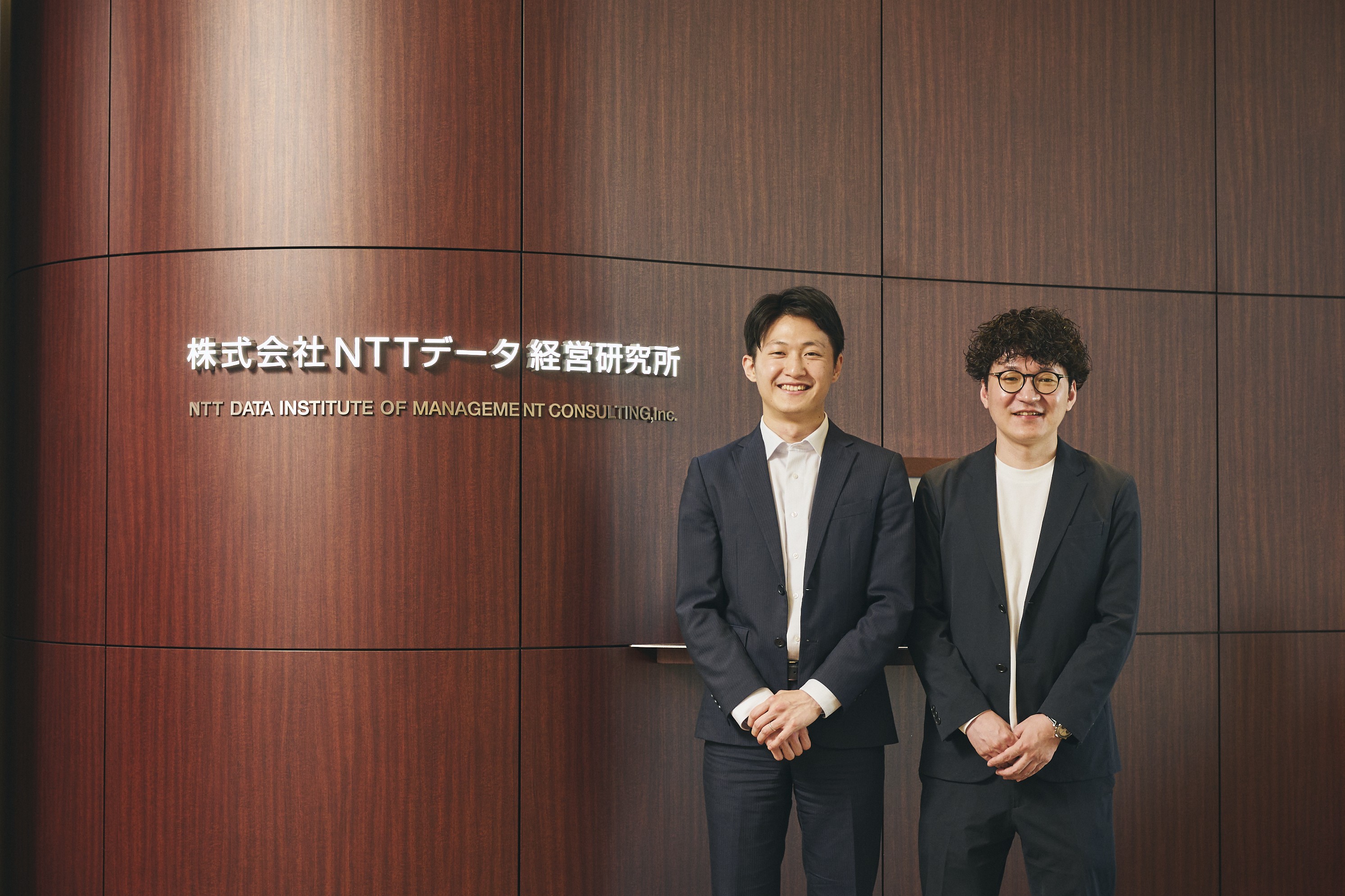Enhanced report creation at NTT DATA with think-cell
- Home
- Product
- Customer success stories
- Enhanced report creation at NTT DATA with think-cell

Since 1991, NTT DATA INSTITUTE OF MANAGEMENT CONSULTING, Inc. has been engaged in consulting services to solve social issues and support corporate reform in areas such as sustainability, healthcare, and regional development. With a corporate philosophy of "Lighting the way to a better society," the company's strength lies in practical consulting in two areas: recommendations for public agencies and business support for private companies.
To improve the quality of materials, ensure brand consistency, and increase value to clients, the company's consulting services division decided to use think-cell as their all-in-one solution for creating top-notch presentations in PowerPoint.
We spoke to Mr. Kota Tokumura and Mr. Taiga Todaka, Manager and Senior Consultant in the Life Value Creation Unit, about the reasons for choosing think-cell, the challenges they faced before, how they have been using think-cell, and the results they have achieved.

|
Name |
NTT DATA INSTITUTE OF MANAGEMENT CONSULTING, Inc. |
|
Business |
Research and consulting services related to corporate management and public administration |
|
Employee count |
400+ |
|
Used think-cell features |
Waterfall charts, Column and bar charts, Line and area charts, Pie and doughnut charts, Scatter and bubble charts, Chart annotations, Excel data links, Gantt charts
Access millions of images and icons, Use 250+ slide templates
Align and resize, Replace and resize fonts |
Challenges
- A lot of person-hours were spent on adjusting the appearance of documents, which squeezed time for thinking and verification.
- Searching and reusing past documents and assets was cumbersome, and a lot of time was spent creating documents.
- The consistency of the corporate brand was not incorporated into each and every document.
Solutions
- Automate and streamline the process of creating the look and feel of their materials.
- Standardize styles and formats to reduce inconsistencies in the quality of documents.
- Unify the tone and color of materials to enhance the client's impression of the company.
Results
- Improved work efficiency by reducing the time required to create Gantt charts, search for assets, etc.
- Created visually appealing materials, allowing teams to focus on building the logic and value of their proposals.
- The uniformity and quality of the proposal materials directly led to an improvement in client evaluations.

- ー What is the work of the Life Value Creation Unit?
Tokumura: I mainly provide consulting and research services for business strategies in the healthcare field. I handle a wide range of topics along the lifecycle, from health promotion to medical care and nursing care, and my main clients include government agencies and nursing care companies that are promoting DX (Digital Transformation).
There are about 100 people in the unit as a whole, and most projects are assigned to 2 to 10 people. Of the 100 people in the unit, about 30 use think-cell. The reason we started using think-cell was that we obtained an account through an email from the Brand Promotion Department. I’vee been using think-cell since the early days of its implementation, so I’ve been promoting its use within the unit.
Todaka: The background of our active use of think-cell is that the creation of presentations using PowerPoint is at the core of our business. It is no exaggeration to say that we create some kind of document almost every day, starting with a proposal to a client, followed by weekly and monthly reports after receiving an order, and ending with a final report for closing a project.
We also use PowerPoint for internal explanatory materials, which include policy sharing within the unit, knowledge accumulation, training materials, and many other things.
- ー How do you view the creation of documents as a part of a consultant's work?
Todaka: The role of a consultant is to make the best recommendations to support the client's decision-making. In this context, preparing presentations is a means to realize the recommendations, not an end.
However, just because it is a means to an end does not mean that it should be neglected. Presentations serve as products for deepening thinking, such as structuring hypotheses and arguments, organizing collected data, and presenting the results of analysis. At the same time, they also serve as a means of communication, helping us accurately and persuasively convey what has been considered to the client.
In addition to presenting objective evidence, the presentations may also include subjective views, such as "What do you personally think? In this sense, it can be said that materials are the realization of the consultant's thoughts and perspectives.
In other words, we consider the process of presentation preparation to be one of the important processes that are indispensable for the establishment of recommendations that support the client's decision-making.

The manual process of creating presentations was taking time away from the consultant's brainstorming

- ー What were some of the issues you were facing in creating presentations before you adopted think-cell?
Tokumura: We had two major issues. First, it was time-consuming and labor-intensive to combine all the documents created by each consultant into a single presentation and to keep them in good order. We felt that we needed to spend more time on brushing up the recommendations, making sure that the presentations were consistent and logically structured, which took away time from thinking about how to make better recommendations. It’s vital that each consultant has enough time to think about the recommendations and to check the consistency and logical structure of each presentation.
The second issue was that the quality of the materials submitted by the consultants varied. It goes without saying that the content and recommendations are important, but the way they are presented is also an indispensable element of the materials. However, the quality of the materials varied depending on the relative experience and skills of the consultants, and we wanted to ensure a high level of consistency in the quality of the materials before they were compiled into presentations to be submitted to the client.
Todaka: The process of improving the appearance of materials is essential for consultants. For example, if multiple slides have inconsistent fonts and color tones, or if the source of the material is not clearly indicated, the client's impression of the material is diminished. Unorganized materials can cause unnecessary stress to the recipient, making it difficult to convey a recommendation, no matter how good and well-founded it may be.
Tokumura: The materials are the starting point in our work as consultants. In meetings with clients, we use the materials as a basis for discussion, designing next actions, and deciding on the final destination. That is why it is a mistake to spend too much time and effort on the task of making the materials look good, thereby reducing the time spent on thinking and research. A product was needed that would reduce the burden of non-essential work and allow us to focus on more valuable output.
The impetus was to strengthen the brand so practical problem-solving was the deciding factor in implementing think-cell

- ー How did you come to know about think-cell?
Tokumura: A senior consultant with practical experience at another firm suggested that we should unify the corporate colors and fonts used in our materials as one of the measures to strengthen our brand power. In fact, major foreign firms have their own corporate colors, and we wanted to remind our clients of "NTT DATA INSTITUTE OF MANAGEMENT CONSULTING, Inc." from the color and style of our proposal materials, which would lead to a long-term commitment to the firm.
In the proposal, think-cell was implemented as a specific product to unify corporate colors and fonts. Since the senior consultant had used think-cell in his previous job at another firm, it was highly regarded as an effective product for strengthening the brand, while also improving work efficiency in creating presentations.
- ー How did you start using it after informing the company about it?
Todaka: The decision to use think-cell is left to the discretion of individual consultants, who apply to our corporate division for an account. I became interested in think-cell when I heard that other firms were also using it. I had always felt that creating presentations was too time-consuming, so I applied for a think-cell account as soon as I received an email from the corporate division. After that, I learned how to use think-cell at a user workshop hosted by think-cell Japan, and started using it when creating my work presentations.
How to use think-cell, covering everything from creating charts and searching for assets to ensuring consistency

-
ー How do you use think-cell Charts’ charting function?
Tokumura: In my work, I use it to create presentations that visualize and manage the entire project. Specifically, I use Gantt charts to visualize project progress . It is especially convenient that, when creating a Gantt Chart, the design is automatically adjusted simply by selecting a date. These two functions alone have reduced the time required to create the entire schedule presentation to one-tenth.
Todaka: I often use charting functions such as funnel charts and bar or column charts when creating proposal materials. In particular, the funnel chart allows me to create charts exactly as I want, and visually communicate changes in the numbers for each phase. Thanks to this feature, we are able to convey detailed information to our clients in easy-to-understand charts, whereas before we had to convey it verbally.
- ー How do you make use of the think-cell Library's content search function?
Tokumura: I found the think-cell Library revolutionary. For example, in order to make it easier to understand the target of our proposals in the healthcare industry, we often insert pictograms of doctors, nurses, and other special characters in our materials. In the past, we would have to go to an external site to find assets that closely resembled the images we wanted to use in our materials, but now, thanks to the think-cell Library, we can find the assets right within PowerPoint.
In addition, by storing internal templates and past materials in a team library, we can instantly call up the slides we want to use. It is very helpful in practice to be able to complete tedious tasks such as searching for assets and reusing past materials in PowerPoint.
ー How do you make use of think-cell Core's functions to support productivity and ensure consistency of materials?
Tokumura: We use think-cell Core for arranging the slides submitted by each consultant to make them consistent. For example, we use a function that automatically aligns and unifies text boxes, and a function that automatically aligns the corporate colors to the specified corporate colors in the style file settings.
More efficient work, higher-quality presentations, positive client evaluates and increased revenue

ー How has the implementation of think-cell changed your workflow for creating presentations?
Tokumura: The biggest change is that we can now completely separate the time spent thinking about the content of the presentation from the time spent preparing the presentation’s appearance. Before, a lot of time was spent on mindless tasks such as aligning figures and manually adjusting colors and fonts.
Now we can leave those tasks to think-cell and concentrate on thinking, discussing, and researching, which is what we consultants should be spending our time on. Of course, the quality of the presentations is stable and comparable to what it used to be.
Todaka: We can now create visually appealing presentations depending on our ideas. Especially in the field of consulting, when slides are easy to understand at a glance and memorable to the client, this has a direct positive impact on the persuasiveness of our recommendations. Although it cannot always be quantified in concrete figures, I believe that the improved expressive power of our presentations has definitely contributed to our improved profitability.
ー What kind of results have you achieved with the implementation of think-cell?
Tokumura: In terms of quantitative results, we feel that the time required to create presentations has been greatly reduced. For example, thanks to the think-cell Library, what used to take nearly an hour can now be completed in less than 10 minutes. In addition, the Gantt Chart functions have reduced the time required to create an entire schedule document by a factor of 10. A task that would have taken 3 to 4 hours with a draft can now be completed in 15 to 30 minutes, a dramatic improvement in work efficiency.
ー What kind of feedback have you received from clients regarding the implementation of think-cell?
Todaka: We have received positive client feedback via our post-project questionnaire, such as, "The overall tone of the documents is consistent and easy to understand," and "The report was very impressive.” In a recent project we worked on with a medium-sized company, the high quality of the presentations was included in the evaluation, which contributed to our decision to discuss the next phase of the project with them.
For us consultants, a report is more than just a set of results. It should be a catalyst that leads to the next decision-making process. We believe that a consistent, uncluttered document is an important factor in supporting our client's business decisions.

We want to spread the use of the system internally outside of consulting, so that the entire company can focus on more essential work.

ー What is your outlook for the future?
Tokumura: As of 2025, there will be about 130 think-cell users in our company, about a quarter of the total. We believe that not only consultants but also planners and corporate staff should actively use think-cell in the future. For example, think-cell's functions will be of great value in situations where proposals are required to organize issues and construct a story.
Of course, simply installing the product is not enough. First of all, we feel that it will be necessary in the future to develop training and support systems, so that people across the company will want to use think-cell.
Todaka: We would like to keep trying out new think-cell functions and explore more ways to make it useful for our consultants. When consultants work together on a project, we assume that everyone can use think-cell, so we would like to go one step further from general use.
ー Do you have any advice for those who are struggling with creating presentation materials?
Tokumura: The value of think-cell is that it streamlines the work related to how presentations look and creates time for thinking. Of course, the appearance of documents is important, but at the end of the day, it is the substance that counts. I believe that think-cell is an effective product for focusing on the creation of substance and concentrating on the work that expert consultants really need to do, which cannot be replaced by generative AI or other automation products.
About think-cell
think-cell is the de facto standard for Microsoft PowerPoint that simplifies work, improving the quality, accuracy and consistency of business presentations. think-cell is used by more than 1,000,000 business professionals in countries across all regions of the world.